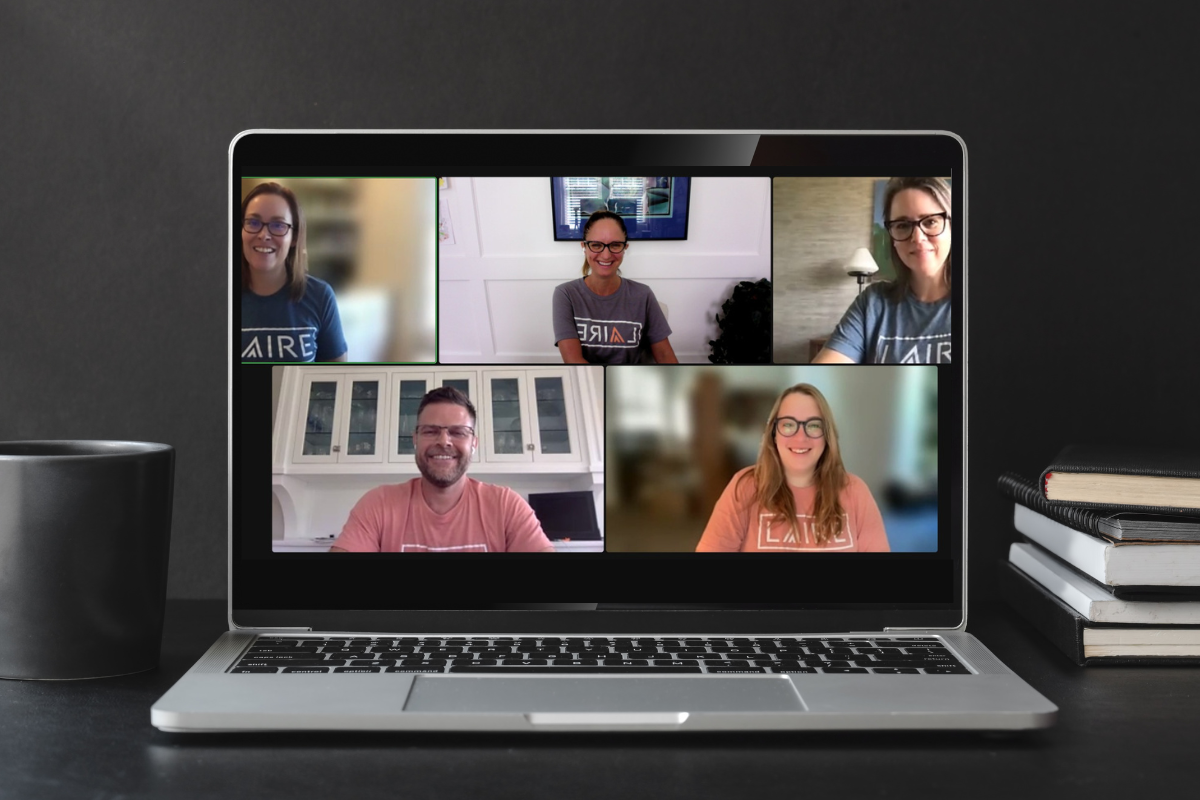Becoming a remote agency can strengthen communication and collaboration. It helps a remote worker discover their strengths. It's no wonder it can increase productivity. But without proper connectivity, working remotely in an agency environment can feel isolating, confusing, and disheartening.
One thing we do know: Improving connectivity is worth the effort. It creates a much better experience for all. Happy workers are more creative and engaged. As a result, you deliver higher-quality work for clients. You can feel greater pride in your career. From C-level to entry level, we can all do our part to increase connectivity.
1. Recognize the Power of Remote Work to Increase Connectivity
Being remote seems like the opposite of "togetherness" and "connectivity". But in actuality, you have greater connection potential.
You can work independently (and undisturbed) more of the time. Simultaneously, collaborative tools make it easier for everyone to stay on the same page.
As a result, most people will get more done, and it's easier for management to see who's engaged and committed to team success.
People can stay organized and interact virtually with team members and one-on-one in a way familiar to most of us. This virtual interaction helps each remote worker build stronger bonds faster.
2. Generate Strong Management Commitment
It's inevitable. Remote workers will feel isolated if management isn't on-board because leaders must lead by example.
The remote agency needs leaders committed to keeping remote employees connected and productive. They must understand the technology they're working with and how to use it to promote connectivity.
This isn't an impossible feat.
But this commitment must start at the top with upper management investing in the technology, infrastructure, and standard operating procedures that make connectivity possible for a remote employee.
3. Encourage Frequent Communication
An email has been a business and personal favorite for some time. But there are many better ways to keep teams communicating.
First, they need an effective communication app that everyone uses. It becomes a part of their workflow to interact with the team via this app.
It saves their contacts and interactions. Ideally, the same tool allows group contact and video when needed.
For the team at LAIRE, we trust Slack as our tool of choice.
4. Institute Regular Check-ins
Managers shouldn't wait for employees to reach out when they have a problem. Instead, they should have standing check-ins where they discuss work progress, challenges, and achievements one-on-one.
In a traditional in-person set-up, this would be hard to pull off. But in a remote setting, where operations are more transparent, performance more trackable, and communication more open, these check-ins become quick and productive.
5. Make Time for Fun
Fun time is not a waste of time when it promotes a healthy, more open, more connected working relationship among remote workers.
Make room for fun communications. People establish friendships when they spend some "downtime" together.
This is how people make "work friends" in an office. And this feature of the work experience shouldn't be ignored.
You should like the people you work with. Working together with people you like is more rewarding. It cultivates appreciation and compassion as well as personal and team pride.
When co-workers are friends, they're kinder. They're more likely to give each other the benefit of the doubt when someone makes a mistake.
They help each other through difficult times and encourage each other toward success. So take time for activities like:
- Virtual scavenger hunt
- Netflix party with live chat
- Trivia
- Friendly competitions
- A virtual book club
- Team health, fitness, and personal improvement challenges
- Virtual happy hours
6. Build a "Good" Communication Culture
Good communication doesn't always mean "more communication". Good communication is "effective". Coach team members toward succinct messages when conveying critical information and updates.
If something needs explanation, they should make sure the most crucial information is conveyed using techniques like:
- Bullets
- Bold
- Summaries
- Key points
- Bottom lines
7. Limit Meetings...There Is a Better Way
Sure, Zoom calls are essential sometimes. But we want to be clear. Staying connected doesn't just mean having more meetings. The connection can happen even when people rarely see or speak with each other. It can happen through tools that keep everyone on the same page.
Now, when you do have a meeting, it meets its goal.
The old style of completing a project involved getting everyone in a room together to discuss the project, hash out details, and bounce ideas off each other.
We won't get into why this is inefficient in person. Just know, that it's even worse in a remote setting.
Each remote worker gets ‘Zoom fatigue’. People stay silent because it's harder to chime in on a call. Those who miss frequent meetings have to play catch up. Ultimately, you are unable to move a project forward.
You have some better options, like asynchronous collaboration technology.
8. Embrace Asynchronous Collaboration
Modern collaboration technology allows teams to work as a unit continually without speaking with each other in real-time.
They can work across time zones or at odd hours and stay in sync with everyone else. They're all logging their progress, adding notes, and completing tasks they've been assigned.
This all updates in real-time. And the project stays on track.
Night Owls can be just as successful as Early Birds. They can all get their work done independently when they do their best work while staying in sync with the team, meeting goals and deadlines.
This asynchronous collaboration enables a more agile workforce. Time, location, and lack of communication are no longer barriers.
9. Promote Transparency in Work
Asynchronous collaboration technology serves another purpose. It creates an element of transparency regarding everyone's role in a project.
Instead of being oblivious to what other team members are doing, each remote worker everyone's progress. They feel motivated to do their part, knowing that every team member is just as committed as they are.
Management can also view the project's progress. They can proactively identify an issue that may cause a delay.
They can redistribute work, provide support, encourage one team member to reach out to another, or do whatever is needed to keep the project on track.
And remote employees can see this taking place. They feel supported.
10. Make Resources Available for Everyone
All team members should know where to find resources that allow them to do their jobs.
- Technology tutorials
- Free online certifications
- Style guides
- Troubleshooting
- Managing objections
- Quarterly calendars
- Helpful apps
- Etc.
This starts with a centralized resource library maintained by the remote agency. But they should also feel empowered to seek out sources that may not be provided.
Management can encourage team members to share resources they discover. That way, they can be vetted and shared with the team.
11. Automate Tedious Tasks
Every remote agency should dig into what the day in the life of each employee looks like. Identify the tedious and mind-numbing tasks team members frequently do. Then automate them.
When team members aren't bogged down with boring, repetitive stuff, they have more time and mental energy for the collaboration and creativity that set a leading remote agency apart from the competition.
12. Evaluate Performance by Results
People who manage by looking over shoulders, tracking how many Saturdays someone works, or expecting people to "look busy" when they walk into a room aren't managing anything.
They struggle when employees go remote because they don't know how to actually measure performance. Overtime = "good employee" as far as they're concerned. This is just what they've learned.
But at the end of the day, none of that matters. Results do.
Every remote employee should know exactly what they're expected to accomplish.
If they get high-quality work done in two hours when it takes someone else eight, it doesn't matter. The results matter. Satisfied customers matter.
But this can be problematic if the employee's objectives aren't clear.
13. Make Goals Clear and Precise
Judging a remote worker based on performance takes a higher caliber of management skills.
A remote agency must be sure they:
- Focus on metrics that actually contribute to business success
- Have effective tools to track, manage, and communicate progress regularly
- Can articulate why this metric is important and an indicator of their performance
- It can show the employee how meeting that metric contributes to business success.
People want to feel a sense of purpose and know that they're making a difference.
14. Have Adaptive Support Policies
Traditional companies often have stringent policies. They've historically micromanaged and rewarded a lack of work-life balance while proclaiming its importance.
A lot of this is changing across the board. But remote agencies are uniquely positioned to rethink everything. That includes these outdated policies that disconnect an employee who may be dealing with a life event from the team.
Adaptive policies implement rules, procedures, and technologies that help a remote employee stay connected and continue to work at varied hours and from anywhere. They don't let a little disruption become a major one because they lack the will or ability to adapt.
As long as employees get work done on time and can communicate effectively, this should be workable. Flexible, adaptive work policies can retain top talent and strengthen their loyalty to the remote agency. They communicate that you value your talent's time, and understand they have their own lives beyond work.
15. Train, Mentor, and Coach Managers
This flexibility doesn't come automatically. Many managers struggle to make it work, and it's not because they're stubborn or aren't trying.
It's important for a remote agency to actively train management on:
- How to coach people remotely
- How to set performance-based goals and communicate them clearly
- How to keep remote employees connected
- How to remain flexible while still ensuring that customers are being taken care of
- Use the technology that makes connectivity possible
16. Set Up a Mentor Program for New Hires
When an in-person team goes remote, everyone already knows each other. They have the advantage of already feeling some co-worker connection.
But when a team is already remote and a new hire enters the mix, it can be much harder for that new person to develop some chemistry with the team. This is especially true with hybrid remote teams.
You may experience high turnover as a result.
Assigning a peer mentor to new hires can help. Many feel intimidated when asking the supervisor or manager everyday questions. They don't want to appear high-maintenance or like they don't know their stuff.
This can be detrimental to onboarding because it's hard for a remote manager to know where a new employee might need extra support.
Having a peer for this can relieve some of that performance pressure.
They can support the onboarding process by ensuring the new remote worker:
- Acclimate to a remote environment
- Feels like a part of the team
- Learns to take advantage of all technologies
- Understands policies, procedures, and compliance
- Has access to all of the resources they need to do their job
Become a Connected Remote Agency
Remote agencies have an excellent opportunity to create an employee-business partnership that works.
By promoting a more connected remote workplace, you build a culture where everyone feels valued, supported, and enabled to do their best work for clients. The company becomes agile and able to evolve with changing client needs, industry trends, and technology. 

